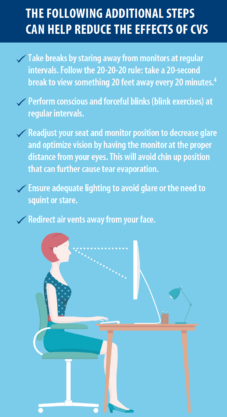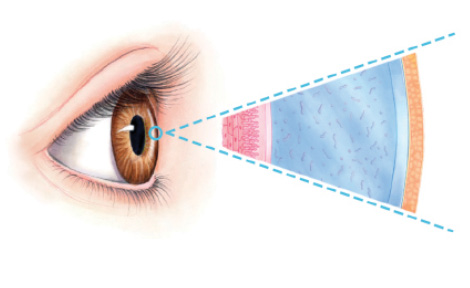
Since the advent of the Internet, the world has become increasingly dependent on digital screens, with over two-thirds of the global population using some kind of smart device on a regular basis.1 Digital gadgets have become such an integral part of our daily lives that it is difficult to remember a time without their existence, although it was not so long ago that we, instead, depended on desk calculators, Rolodexes, and paper calendars.
AT A GLANCE
- As many as 50% to 90% of people who use a computer or an electronic device with a screen complain of some symptoms associated with computer vision syndrome (CVS), which may include blurred vision, transient double vision, foreign body sensation, red eyes, irritated eyes, the need to blink forcefully to clear vision, and headaches.
- CVS can be aggravated by inspissated or lost meibomian glands. Staring at a screen reduces the blink rate from an average of 30 per minute to about four per minute. This decreased frequency of blinking affects the force necessary for the glands to pump sufficient meibum through their orifices onto the ocular surface.
- CVS includes an observable group of symptoms with identifiable causes and a variety of solutions.
As many as 50% to 90% of people who use a computer or an electronic device with a screen complain of some symptoms associated with computer vision syndrome (CVS), which may include blurred vision, transient double vision, foreign body sensation, red eyes, irritated eyes, the need to blink forcefully to clear vision, and headaches.2,3 CVS is especially pervasive in the developed world, where many occupations require long hours in front of computer screens. Hours spent watching television, playing video games, or using electronic devices exacerbate symptoms.

Just as repetitive movements that strain poorly positioned muscles cause carpal tunnel syndrome, CVS is triggered, in part, when eyes are strained by a repetitive back-and-forth motion on a small screen area over and over all day long. Compounding factors can include refractive errors, dry eye disease (DED), contact lens-related problems, and undiagnosed ocular or environmental issues.
IN THE BLINK OF AN EYE
CVS can be aggravated by inspissated or lost meibomian glands. Staring at a screen reduces the blink rate from an average of 30 per minute to about four per minute. This decreased frequency of blinking affects the force necessary for the glands to pump sufficient meibum through their orifices onto the ocular surface.3 Evaporative DED may ensue (Figure 1).


Climate-controlled offices do not help matters. Artificially heated or cooled air affects the ocular surface further. Not only does meibomian gland dysfunction exacerbate CVS, but ignoring the symptoms can lead to progression of the disease process (Figure 2).

SOLUTIONS
CVS includes an observable group of symptoms with identifiable causes and a variety of solutions. Educating patients on CVS is key to helping those who are suffering in silence.
The first line of defense is for patients to get a comprehensive eye exam from a provider who specializes in DED that includes appropriate diagnostic testing. Of course, adherence to any recommended treatment then becomes paramount.
Digital devices are here to stay, and that means CVS will not be going away anytime soon.
1. Global Attitudes Spring 2015 Survey. Pew Research Center. http://bit.ly/2015attitudes. Published June 23, 2015. Accessed June 14, 2017.
2. What Is Computer Vision Syndrome? WebMD. http://bit.ly/webMDCVS. Accessed June 14, 2017.
3. Computer Vision Syndrome. University of Iowa Hospitals & Clinics. http://bit.ly/UniversityofIowa. Accessed June 14, 2017.
4. Computer Vision Syndrome. American Optometric Association. http://bit.ly/AOAcomputer. Accessed June 14, 2017.




